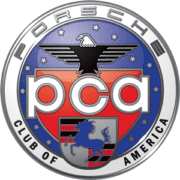Reference Points
As this is the October P4Us we should be about ready to hold our next DE (October 17-18) at the really fun Lightning track at New Jersey Motorsports Park (NJMP). Not too long after that on October 30 – November 1, we will have our final event at Virginia International Raceway (VIR). Just as a reminder, in 2016 we will be back at Watkins Glen for our usual Advanced DE in mid-September.
In an article or two ago, I wrote about the different phases of a turn and that there is an optimal line through every corner. For consistency, the driver will need a set of fixed reference points to mark the phases of the corner, so the line can be driven identically every lap.
Reference Points
At most DE’s, we supply the critical reference points with nice bright orange cones. There is a school of thought that on day two of an event and particularly day three of a three day event, we should pull the cones. The point of this article is to get you to think about developing reference points, other than the orange cones.
Upon approaching a corner, the driver needs a fixed point to use as a reference for starting the turn-in. Guessing each time or “going by the feel” will guarantee that the driver will turn in too soon sometimes and too late other times. Inconsistent and slower than perfect lap times (not that we are timing) will result. The first time you drive a new track you must determine the correct starting point for the turn-in and find a permanent visual landmark to use for reference.
Next, is the apex point. This is the target point that the inside tire of the car should touch as it reaches the maximum inside point of the driving line. Again, without a fixed point to target, inconsistency and slower times will result. Last, is the exit point. This is the target point after the apex that the car tracks out to on the opposite side of the track and is completely pointed straight again, or is otherwise pointed properly for the next corner.
In each case, the reference point should be a permanent land mark. A tire skid on the track is no good. Other skids later on could obscure the original one. Likewise, a particular rock, weed or grass tuft on the side may be questionable if they are in danger of being drive over if a car goes off course. You should look for unique features in the road itself if possible. Some tracks have permanent signs in the braking zones. You might start braking exactly at one of the markers or a car length before or after.
At the corner apex most permanent road course tracks will have the white or red and white cement rumble strips. When you find the right apex point, note whether it is half way, three-quarters, or wherever, and aim for that spot each time.
The corner exit reference point can be the toughest to find. Many tracks have exit markers just like the apex which can be used, but not all. You may have to search for other fixed landmarks off the track that the car exit path lines up with such as telephone poles, trees or signs.
What about a reference point for the start of braking? There is some debate about this. Some people suggest that there should not be a reference point for the start of braking. The argument is that the turn-in point is the focus and the driver must learn to sense when to start the braking to achieve the proper speed at the turn-in point. It is assumed that some laps will be faster than others because traffic is involved and with all these variables, the focus must be placed on the turn-in point, not in looking for the braking point which may be too soon for slower speeds. This is a valid theory.
Nevertheless, one of the key attributes of skilled driving is consistency and one of the keys to consistency is reference points. In any high performance driving, a braking reference point is just as effective for marking the capabilities of the car’s performance (for braking) as is the turn-in point (for corner entry grip) and the acceleration point (for corner exit grip). An example of where a braking reference point is a must, is a blind corner. A corner at the top of, or just below, the crest of a hill will not be visible to the driver during braking.
The debate of whether there is or should be a reference point for braking is largely semantics. Physiologically, your mind and body needs some reference to know when to start braking and how to make that action consistent. For braking, the term “reference point” its self describes the purpose. It is a point of reference and will not be so much a “target” as it is for the turn-in, apex and exit points. If the driver is at maximum speed before the turn, he is going to need to know when to start braking. If another lap is slower, he will know he can start braking a little later. Regardless of how it is used and whether you call it a “reference point” or not, having a point or reference for the maximum braking performance of the car for each turn avoids guessing.
So, the next time you are on track, establish your reference points and see how they work for you or ask your Instructor or a Chief, what they use. I remember asking Bill Gilbert what his turn in point was for Turn 1 at Watkins and he mentioned something about a square shape outlined on the track where the pavement was re-surfaced or seal coated. Opps!! Watkins is being repaved so we are going to need to find something else Bill. LOL.
Thanks to Turn Fast for the material for this article.
Tom Iervolino, NNJR-PCA Track Chair


